| Author |
Message |
|
D. S. Smith
Location: Central CA Joined: 02 Oct 2011
Posts: 236
|
 Posted: Thu 02 Feb, 2012 9:07 pm Post subject: Scottish sword hilts Posted: Thu 02 Feb, 2012 9:07 pm Post subject: Scottish sword hilts |
 |
|
Hello all, I'm wondering if anyone can provide a link to Scottish hilt styles similar to what Albion uses on the Laird.
http://www.myArmoury.com/review_alb_laird.html
I absolutely love this style of hilt and crossguard, but it seems much more complex than the other type XII blade hilts I see on this site (or many of the other blade types for that matter). I know the forward canted crossguard with the "flowery" ends is traditional for the claymore, but I'm having a hard time finding a single handed sword with a hilt anywhere close to resembling the Laird.
I'll be the first to admit that I'm completely new to the istory of medieval swords, so more likely than not I'm simply looking in the wrong places. The bottom line is I'd love to see a single handed sword (not a reproduction) with a hilt resembling the Laird.
|
|
  |
 |
David Wilson

Location: In a van down by the river Joined: 23 Aug 2003
Posts: 803
|
|
   |
 |
|
D. S. Smith
Location: Central CA Joined: 02 Oct 2011
Posts: 236
|
 Posted: Fri 03 Feb, 2012 12:26 am Post subject: Posted: Fri 03 Feb, 2012 12:26 am Post subject: |
 |
|
|
Thanks David, those are great! Exactly what I was hoping for.
|
|
  |
 |
Thomas McDonald
myArmoury Alumni


|
 Posted: Fri 03 Feb, 2012 4:39 am Post subject: Posted: Fri 03 Feb, 2012 4:39 am Post subject: |
 |
|
The guards terminals on this Irish find look very similar to what Albion did with thier Laird sword.
(see attached pic)
Photo: "Sixteenth Century Irish Swords In The National Museum Of Ireland"
by G.A. Hayes-McCoy, Dublin 1959.
Mac
 Attachment: 105.37 KB Attachment: 105.37 KB
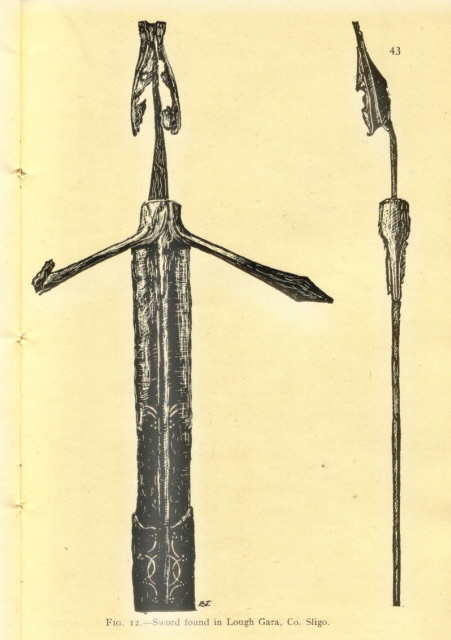
'Gott Bewahr Die Oprechte Schotten'
XX ANDRIA XX FARARA XX
Mac's PictureTrail
|
|
   |
 |
|
James Moore
|
 Posted: Fri 03 Feb, 2012 4:41 am Post subject: Posted: Fri 03 Feb, 2012 4:41 am Post subject: |
 |
|
D.S; I would suggest talking to James Elmslie ( www.elmslie.co.uk ), who's a craftsman actually from the highlands - I know from talking to him that he's done detailed first-hand studies of about half of the medieval scots singlehanders that still exist, and he's more than happy to share data with people.
I was talking to him recently and he's got amazing photographs of some of them. We were discussing details of the hilts, and according to what he was finding, there's some notable differences among some of them to what you (or I) would expect, as the scots hilt crosses often have very significant hollow sections in them, with much more complexity of design unlike almost all modern replicas. Also unlike the replicas, apparently there's metallurgical analysis that indicates at least 1/3 of the surviving ones have evidence of gilding or silver-gilt on cross and/or pommel.
well worth getting in touch with him.
|
|
  |
 |
J.D. Crawford

|
 Posted: Fri 03 Feb, 2012 6:32 am Post subject: Posted: Fri 03 Feb, 2012 6:32 am Post subject: |
 |
|
Some people call these 'halflangs'
Here's another original: http://dirkdance.tripod.com/sitebuilderconten...swords.jpg I believe this picture originates from the Glasgow museums web-site, which has a couple of more pics.
If you are looking for a budget piece, here are a few:
http://www.highlandarmoury.com/halflang-sword...-2352.html
http://www.swordsdirect.com/battle-ready-scottish-swords.html
There were a couple more out there, but everything I have seen in this range was historically innaccurate and/or poor quality.
Here's one with a 'Scottish look', more or less by accident because it is supposed to be another type eof sword: http://www.kultofathena.com/product.asp?item=...ight+Sword
The only historical looking mid-range product that I know if is this one by Del Tin:
http://www.deltin.it/5151.htm
It is said to be pretty good. But it might be hard to find. I think I saw it listed at 'Work of Art' if that's still around. Kult of Athena might order it for you. Otherwise direct orders from Del Tin can take a while, I think.
On the higher end, Vince Evans has made some nice ones. You just missed a couple for sale on e-bay about two weeks ago.
Like you I spent a lot of time looking for a good affordable scottish medieval sword. There's just not a lot out there that one can reccommend. I even tried comissioning a custom piece but it did not work out. So I ended up buying one of the Albion pieces (the Caithness, not the Laird). I'm not one to discourge people from buying affordable swords, because often there are plenty of good ones out there, but in this particular case it's probably worth saving for the one you really want.
|
|
   |
 |
T.F. McCraken

Location: Ingleside, Illinois Joined: 13 Apr 2006
Posts: 128
|
|
   |
 |
Vincent C

Location: Northern VA Joined: 24 Aug 2009
Posts: 84
|
 Posted: Fri 03 Feb, 2012 8:58 am Post subject: Posted: Fri 03 Feb, 2012 8:58 am Post subject: |
 |
|
The highland hand a half from armourclass is nice, I have a blunt one, never seen or handled the sharp. I love the one I have though.
http://www.armourclass.co.uk/Data/Pages/Scott...ction2.htm
I partner drill and spar with it all the time, I've had for years and it's still fine. Heavy for it's size, but it's agile and quick.
Also, I know that claymore armoury offers the "spoon guard" hand a halfs as well, but they have no pictures or stats and I've never seen them.
Honor, compassion, knowledge.
|
|
  |
 |
|
D. S. Smith
Location: Central CA Joined: 02 Oct 2011
Posts: 236
|
 Posted: Fri 03 Feb, 2012 11:41 am Post subject: Posted: Fri 03 Feb, 2012 11:41 am Post subject: |
 |
|
| Thomas McDonald wrote: | The guards terminals on this Irish find look very similar to what Albion did with thier Laird sword.
(see attached pic)
Photo: "Sixteenth Century Irish Swords In The National Museum Of Ireland"
by G.A. Hayes-McCoy, Dublin 1959.
Mac |
Thanks for the info folks! Thomas, your photo is great! I agree that it looks very similar to the Laird. But that is part of what confuses me. According to the article (on this site) about Type XII blades, it seems they range from roughly 1100-1350ish. The crossguard on the Laird just seems to me like it would belong on a much later sword. Your photo would bear this theory out, since it is from the 16th century. In fact, long before I saw the pictures in this thread, I told my wife that I thought the Laird's crossguard would look very much at home on a Type XVIII blade. It's beginning to look like my novice guesswork was not far off the mark.
I appreciate the recommendations for more affordable Scottish swords, but honestly, I'm sold on Albions now (especially after receiving my Crecy last week). I hate to sound snobbish, but I think the Crecy spoiled me to the point I might not be happy with anything else besides an Albion.
|
|
  |
 |
J.D. Crawford

|
 Posted: Fri 03 Feb, 2012 1:30 pm Post subject: Posted: Fri 03 Feb, 2012 1:30 pm Post subject: |
 |
|
| D. S. Smith wrote: | | Thanks for the info folks! Thomas, your photo is great! I agree that it looks very similar to the Laird. But that is part of what confuses me. According to the article (on this site) about Type XII blades, it seems they range from roughly 1100-1350ish. The crossguard on the Laird just seems to me like it would belong on a much later sword. Your photo would bear this theory out, since it is from the 16th century. In fact, long before I saw the pictures in this thread, I told my wife that I thought the Laird's crossguard would look very much at home on a Type XVIII blade. It's beginning to look like my novice guesswork was not far off the mark. |
Ahhh, I see wherre you are going. I also worred about that with the Albions. So, one source of information is to look at Scottish graveslabs. (just do a google search and tons of those will show up). There are many of these depicting one-hand swords with downswept guards, especially in the Western Highlands and Isles (although these have lobated pommels like the Caithness). Unfortunately, it is difficult to discriminate what kind of blades these had. However, these grave slabs are thought to date through quite a while 13th-15th century. The convential wisdom is that blades were imported and hilted locally. Based on this, it is quite possible that some of the early ones would have been XII, like the Albion Laird or Caithness.
So I think the Albions are at least plausible (you wouldn't expect Peter Johnsson to tolerate anything else), but you are likely right that the later ones were XIIIb, XV, XVI, XVIII...whatever they could get their hands on that was broad and good for cutting. That is certainly born out by the few survivers, like those shown above.
So this leaves you with at least two options - Albion, or something custom that fits exactly what you want. I've been thinking again about pursuing the custom route myself, but it sounds like I'm after something a bit different than you.
|
|
   |
 |
J.D. Crawford

|
 Posted: Fri 03 Feb, 2012 1:39 pm Post subject: Posted: Fri 03 Feb, 2012 1:39 pm Post subject: |
 |
|
By the way, I know this is getting a bit off your question, but if you're in the market for a Gaelic XVIII, here's a sweet little number from A&A: http://www.arms-n-armor.com/sword085.html
I know they'd be happy to make you a Scottish style sword based on this or one of their other blades...they are great with this kind of thing if you can wait a while.
|
|
   |
 |
Luka Borscak

|
|
  |
 |
Michael Harley

Location: Melbourne, Australia Joined: 12 Apr 2006
Posts: 94
|
 Posted: Mon 06 Feb, 2012 4:28 pm Post subject: Posted: Mon 06 Feb, 2012 4:28 pm Post subject: |
 |
|
Here's one along the same lines.
 Attachment: 51.51 KB Attachment: 51.51 KB
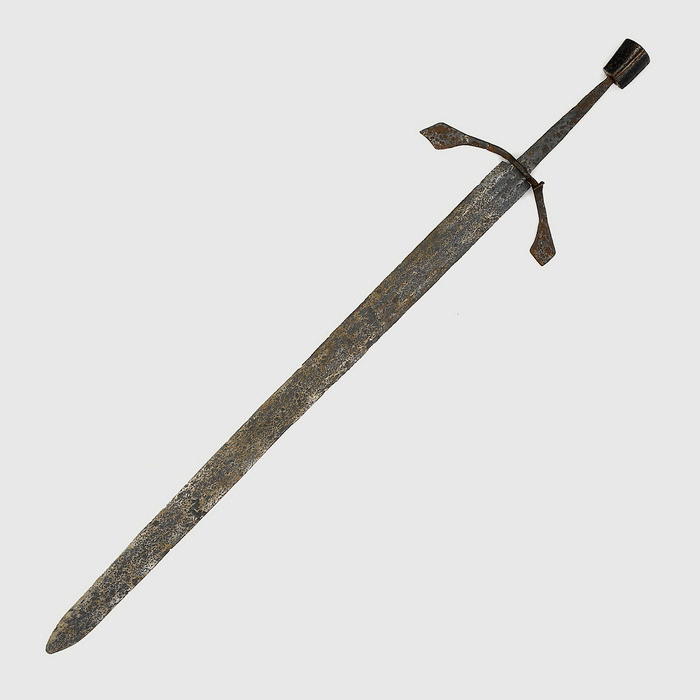
Sword ca.1500 Scot./Scand. 975mm
|
|
   |
 |
J.D. Crawford

|
 Posted: Mon 06 Feb, 2012 4:40 pm Post subject: Posted: Mon 06 Feb, 2012 4:40 pm Post subject: |
 |
|
| Michael Harley wrote: | | Here's one along the same lines. |
Thankyou Michael, that's quite helpful for the project I have in mind.
Is 975mm the length of the blade or the full sword? Do you have any more information on this sword?
|
|
   |
 |
Michael Harley

Location: Melbourne, Australia Joined: 12 Apr 2006
Posts: 94
|
 Posted: Mon 06 Feb, 2012 7:52 pm Post subject: Posted: Mon 06 Feb, 2012 7:52 pm Post subject: |
 |
|
975mm is the overall length and that's all I have on it.
Cheers.
|
|
   |
 |
J.D. Crawford

|
 Posted: Tue 07 Feb, 2012 9:01 am Post subject: Posted: Tue 07 Feb, 2012 9:01 am Post subject: |
 |
|
| Michael Harley wrote: | 975mm is the overall length and that's all I have on it.
Cheers. |
It's an interesting sword if its all authentic
- a double fuller XIII blade, with proportions similar to the well known triple fuller XIII in Oakeshott's 'Records'.
- the cross looks Scottish in terms of the flattened diamond ends and downsloping quillons (assuming these are not bent), except it is lacking in the usual large ecusson or extension toward grip.
- the pommel is unusual, although I think I've seen something like this on a Swedish sword?
Maybe Peter Johnsson knows something about this sword.
- JD
|
|
   |
 |
|
Peter Johnsson
Industry Professional
|
 Posted: Wed 08 Feb, 2012 12:37 am Post subject: Posted: Wed 08 Feb, 2012 12:37 am Post subject: |
 |
|
It is an interesting sword that Michael posted.
To mee it looks like a composite of parts of different origin, or at least of different influence.
The blade is perfectly possible to see on a Scottish sword. It seems to be a German export/import blade. It would be typical for Scottish swords to have imported blades. This means that those blades that were in use in other parts of Europe could find their way to Scotland. Later we see examples of german blade smiths making blades that cater specifically for local taste of scottish sword makers and swordsmen. I do not know how early this "custom production" of export to Scotland was the practice. My impression is that this is something that happens in the 16th century.
The sword in the photo above has a guard that looks like an early example of the typical Scottish guard. It could be a 13th or 14th century sword guard, meaning it could well be contemporary to the blade.
It could also be a later example of an earlier type of blade, specially made for the scottish market, but then the guard seems to be too old fashioned.
The pommel to me looks like a central european type that is found on early katzbalger swords. There is one very much like this on display in the army museum in Paris.
So, we have a blade and a guard that possibly can be dated to the 13th or 14th century and a pommel from the early 16th century.
Odd.
I feel I must also remark that there is something with the guard, that makes me wonder if it is genuine. It is very thin at the cross, where the tang pass through its middle. This is seen sometimes, but to my eyes look very amateurish. The guard to me looks like the work of a not so skilled smith. This does not automatically make it a modern fake, but it is cause for some reservation.
This is judging the photograph. The impression may be different when seeing the sword in real life.
It may be a historical composite, or it may be a composite that is much more recent.
 Attachment: 75.22 KB Attachment: 75.22 KB
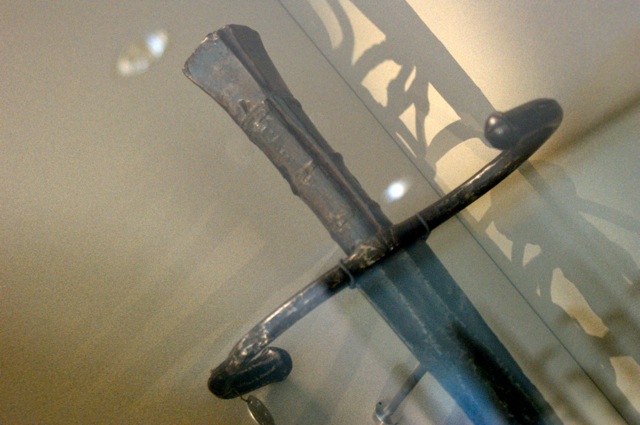
katzbalger on display in Paris
|
|
   |
 |
|
Peter Johnsson
Industry Professional
|
 Posted: Wed 08 Feb, 2012 12:46 am Post subject: Posted: Wed 08 Feb, 2012 12:46 am Post subject: |
 |
|
One comment about type XII blades on early scottish swords. There is such a sword in Glasgow.
Type XII and XIII blades and their cousins would be the first choice to scottish knights of the 13th and 14th centuries. Just like they were for knights in other parts of europe at this time. Very few survive today. Most of the swords we have from Scotland and Ireland come from the 16th century and later. That is why we have to make some educated guesses when we want to make a reconstruction of the kind of sword that would have been available to scottish warriors in the high medieval period. We know from grave effigies their general outline and size. We can now what kind of hilt and scabbards they had. From the profile and size of the scabbard we can draw conclusions about what kind of blade was reasonably inside.
This means type XII and XIII (XIIIb) seems to have been popular choices.
|
|
   |
 |
|
D. S. Smith
Location: Central CA Joined: 02 Oct 2011
Posts: 236
|
 Posted: Wed 08 Feb, 2012 1:32 pm Post subject: Posted: Wed 08 Feb, 2012 1:32 pm Post subject: |
 |
|
| Peter Johnsson wrote: | One comment about type XII blades on early scottish swords. There is such a sword in Glasgow.
Type XII and XIII blades and their cousins would be the first choice to scottish knights of the 13th and 14th centuries. Just like they were for knights in other parts of europe at this time. Very few survive today. Most of the swords we have from Scotland and Ireland come from the 16th century and later. That is why we have to make some educated guesses when we want to make a reconstruction of the kind of sword that would have been available to scottish warriors in the high medieval period. We know from grave effigies their general outline and size. We can now what kind of hilt and scabbards they had. From the profile and size of the scabbard we can draw conclusions about what kind of blade was reasonably inside.
This means type XII and XIII (XIIIb) seems to have been popular choices. |
Thank you Peter, I appreciate the explanation, it makes much more sense to me now. And as I've said before, I am completely new to the history of swords and never doubted that an experienced swordsmith would make something authentic, I hope it didn't come across that way. I was simply trying to wrap my head around the reasoning behind it based on the little I know now.
Edited to add: To me, swords like the Albion Knight and Crecy are the personification of what a classic medieval sword should look like. But from the standpoint of asthetics, the Laird is the most beautiful sword I've seen. The shapes, design, and proportions are stunning.
|
|
  |
 |
Jonathan Fletcher

|
 Posted: Sun 01 Sep, 2013 3:58 pm Post subject: West Highland sword hilts Posted: Sun 01 Sep, 2013 3:58 pm Post subject: West Highland sword hilts |
 |
|
Just to add a few photo's to this old thread which support what Peter says.
All of these come from a trip to St. Clement's church, Rodel, on Harris in the Outer Hebrides yesterday.
Several swords with West Highland hilts are depicted on effigies and carved grave slabs: Most of the swords are hand and half with scabbards that suggest broad bladed cutting swords.
The last photo shows the effigy of a knight in armour and is supposed to be Alastair Crotach MacLeod, d.1528. Another almost identical but more worn effigy is supposed to be that of Alastair's son William (the harness is identical, perhaps the same sculptor made both, perhaps the very same harness depicted, or maybe the same 'studio model' was used to carve each effigy). Another effigy of uncertain date is shown in the second to last photo and depicts a figure in much simpler armour of padded gambeson and maille with an open bascinet. All of the effigies sport what appear to be broad bladed cutting swords with long grips.
The armour, similar to other Hebridean and West coast monuments from the period of the Lordship of the Isles, seems a little dated by Lowland and English standards, assuming the attributions are correct. Perhaps the attire depicted was formalised/traditional, not supposed to be a true representation? Or, perhaps the padded gambeson, maille hauberk and bascinet was still the standard in the West Highlands despite European trends: Could this account for why these broad bladed cutting swords continued in use at such late dates?
Some pictures a bit grainy, lighting as nature allowed and my compact struggled a bit.
 Attachment: 197.32 KB Attachment: 197.32 KB
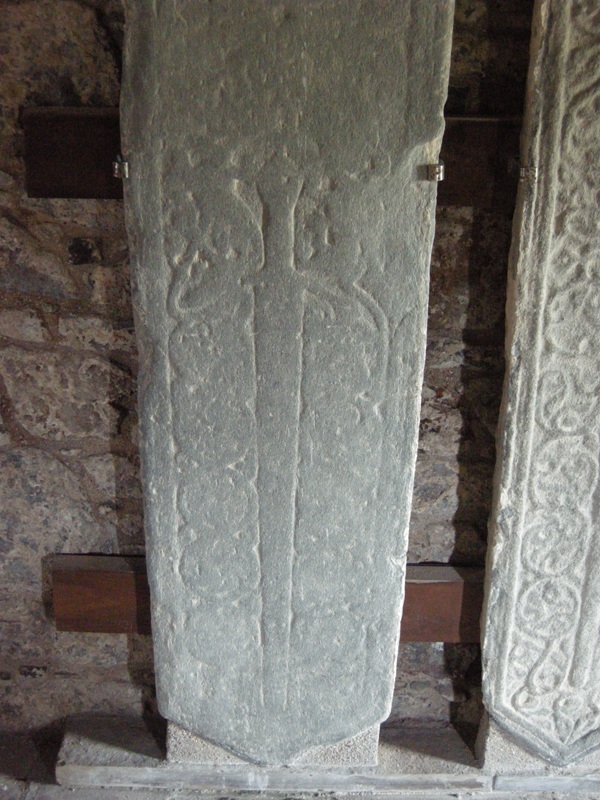
 Attachment: 207.23 KB Attachment: 207.23 KB
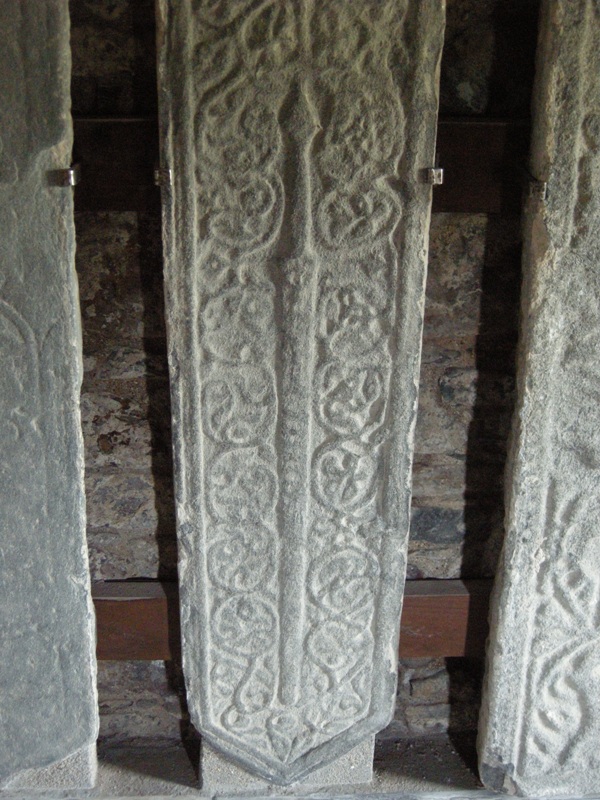
 Attachment: 215.92 KB Attachment: 215.92 KB
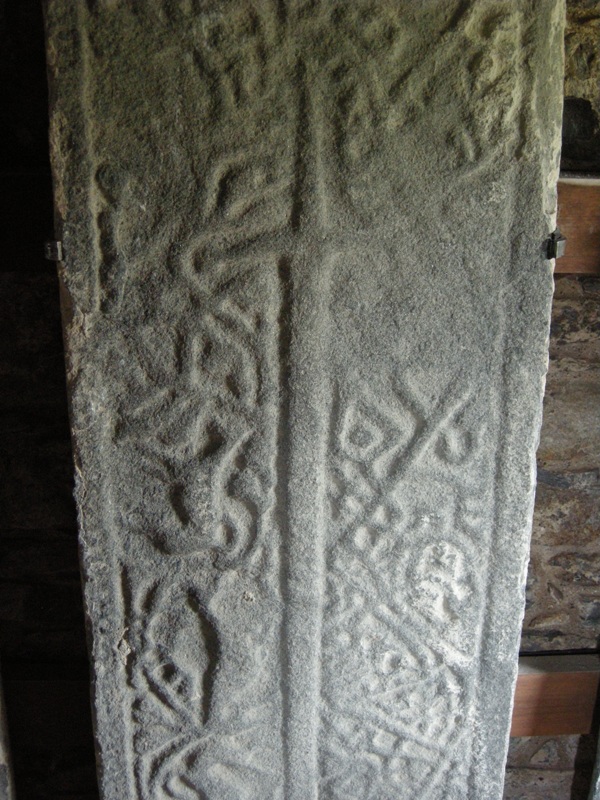
 Attachment: 226.39 KB Attachment: 226.39 KB
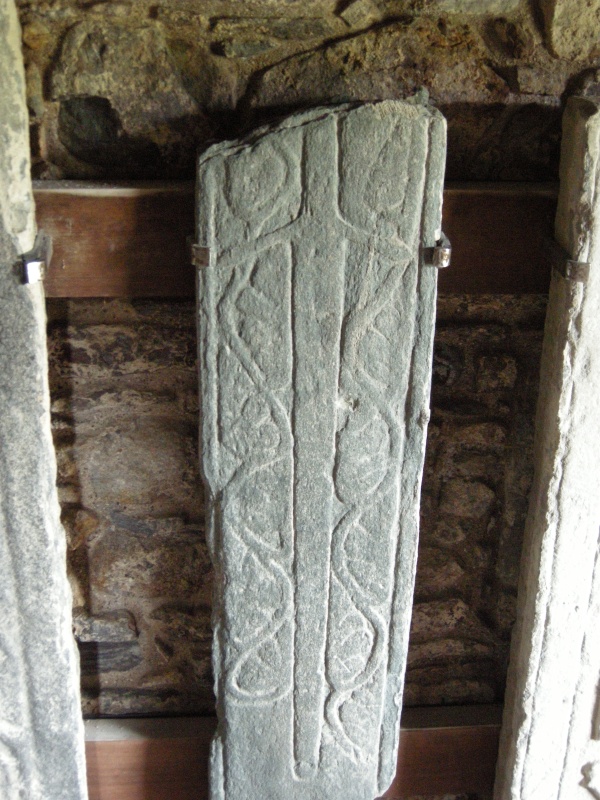
 Attachment: 210.02 KB Attachment: 210.02 KB
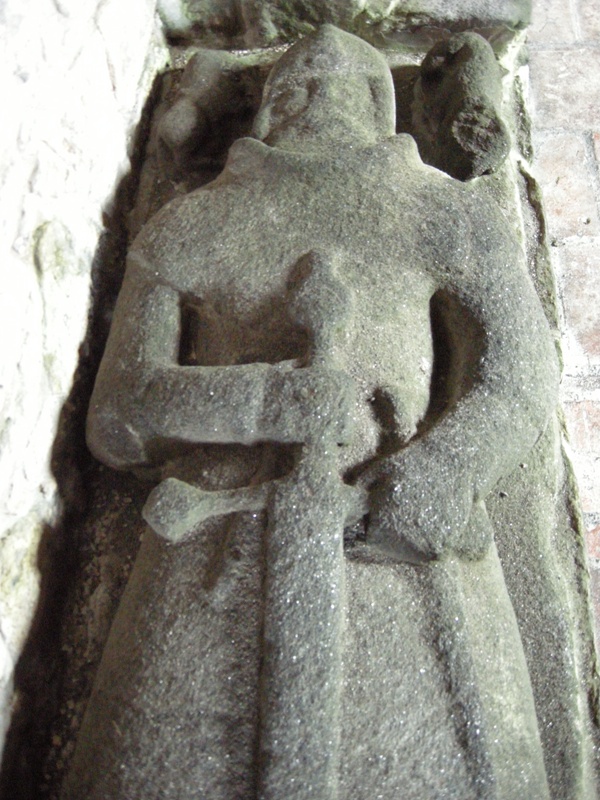
 Attachment: 198.5 KB Attachment: 198.5 KB
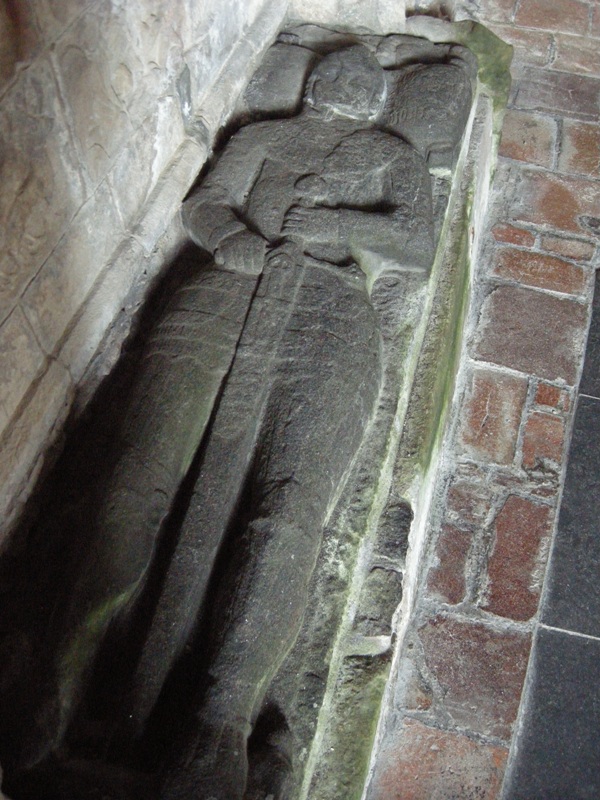
Last edited by Jonathan Fletcher on Sun 01 Sep, 2013 4:35 pm; edited 1 time in total
|
|
  |
 |
|
|

